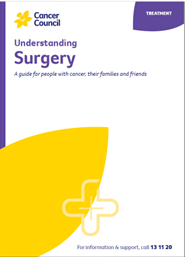- Home
- Skin cancer
- Treatment
- Surgery
Surgery for skin cancer
Surgery to remove the cancer (surgical excision) is the most common treatment for invasive basal cell carcinoma BCC and squamous cell carcinoma SCC. Most small skin cancers are removed by a GP or a dermatologist in their consulting rooms. A surgeon may treat more complex cases.
Learn more about:
What happens during surgery?
The doctor will use a local anaesthetic to numb the affected area, then cut out the skin cancer and some nearby normal-looking tissue (margin). This margin may be very small or around 1 cm depending on the type of skin cancer and where it is on your body.
A pathologist checks the margin for cancer cells to make sure the cancer has been completely removed. The results will usually be available in about a week. If cancer cells are found at the margin, you may need further surgery or radiation therapy.
For more on this, see our general section on Surgery.
Mohs micrographic surgery
Mohs micrographic surgery is usually done under local anaesthetic by a Mohs trained dermatologist or Mohs specialist. It is used to treat skin cancers that have poorly defined edges. Mohs micrographic surgery may also be used for cancers in areas that are hard to treat, such as near the eye or on the nose, lips and ears.
This procedure is done in stages. The doctor removes the cancer little by little and checks each section of tissue under a microscope. They keep removing tissue until they see only healthy tissue under the microscope. Mohs surgery aims to reduce the amount of healthy skin that is removed along with the cancer.
Having Mohs surgery depends on where the skin cancer is and how aggressive or advanced it is. This technique costs more than other types of surgery. Special equipment and training are needed, so it’s available only at some hospitals or clinics.
Repairing the wound
Most people will be able to have the wound closed with stitches. You will have a scar. This should be less noticeable over time. The area around the excision may feel tight and tender for a few days.
If you have a large skin cancer removed, your doctor will explain the most suitable type of reconstruction for your wound. This may be a:
- skin flap – when nearby loose skin and underlying fatty tissue is moved over the wound and stitched
- skin graft – when a thin piece of skin is removed from another part of the body (the donor site) and stitched over the wound. The donor site may be stitched, or it may be dressed and allowed to heal by itself.
Skin flaps and grafts are often done as day surgery in hospital under a local or general anaesthetic, but may be done in a doctor’s rooms. The affected area will heal over a few weeks. Whether you have an excision or Mohs surgery, sometimes you may need more complex reconstructive surgery. This can involve more than one reconstruction technique, surgery that is done in stages, and a longer stay in hospital.
Learn more about the different types of skin cancer.
→ READ MORE: Curettage and electrodesiccation
Podcast: Making Treatment Decisions
Listen to more podcasts for people affected by cancer
A/Prof Victoria Mar, Director, Victorian Melanoma Service, Alfred Hospital and Monash University, VIC; Tracey Bilson, Consumer; Raelene Buchan, Consumer; Alison Button-Sloan, Consumer; Dr Margaret Chua, Radiation Oncologist, and the Skin Radiation Oncology team, Peter MacCallum Cancer Centre, VIC; Prof Anne Cust, Deputy Director, The Daffodil Centre, The University of Sydney and Cancer Council NSW, Chair, National Skin Cancer Committee, Cancer Council, and faculty member, Melanoma Institute Australia; A/Prof Paul Fishburn, Skin Cancer Doctor, Norwest Skin Cancer Centre, NSW and Faculty of Medicine, University of Queensland; Danielle Goss, Melanoma Clinical Nurse Specialist, Amie St Clair Melanoma (part of Melanoma Institute Australia), Wagga Wagga, NSW; Louise Pellerade, 13 11 20 Consultant, Cancer Council WA: Dr Shireen Sidhu, Head of Dermatology, The Royal Adelaide Hospital, SA; Dr Amelia Smit, Research Fellow – Melanoma and Skin Cancer, The Daffodil Centre, The University of Sydney and Cancer Council NSW; Dr Tony Tonks, Plastic and Reconstructive Surgeon, Canberra Plastic Surgery, ACT.
View the Cancer Council NSW editorial policy.
View all publications or call 13 11 20 for free printed copies.
